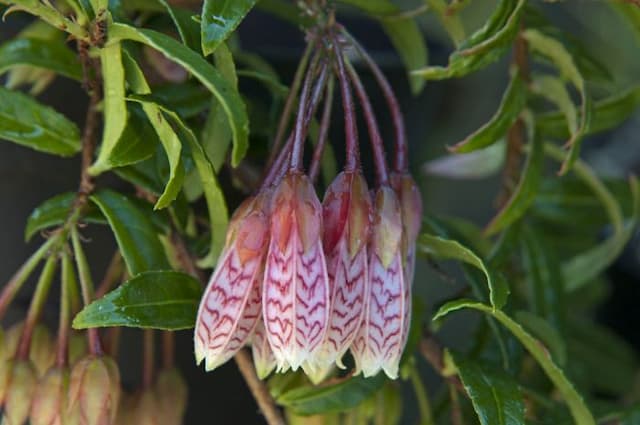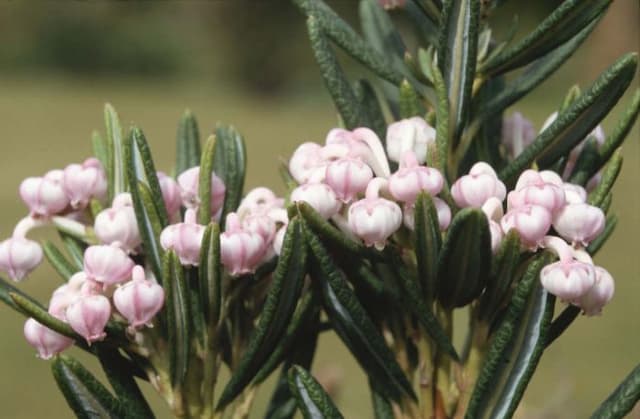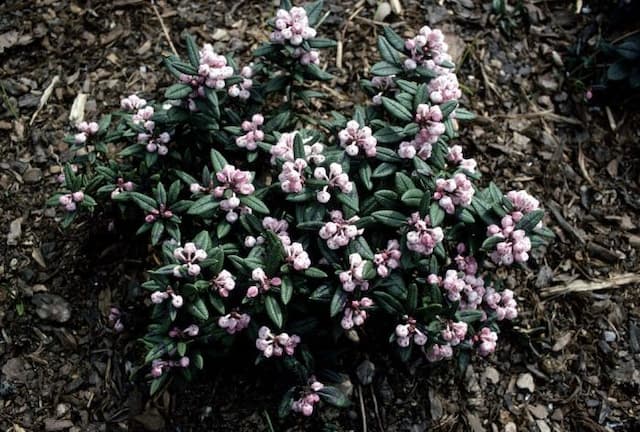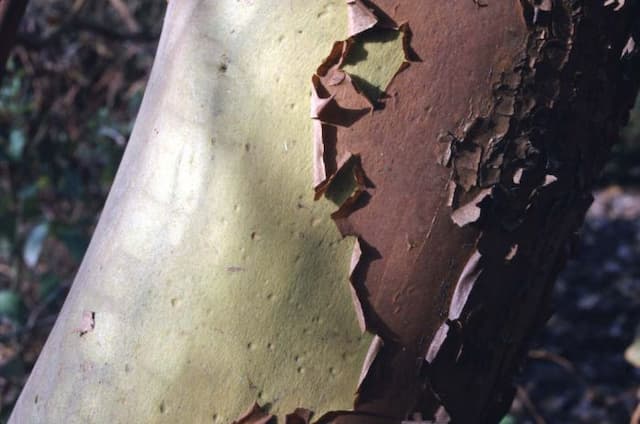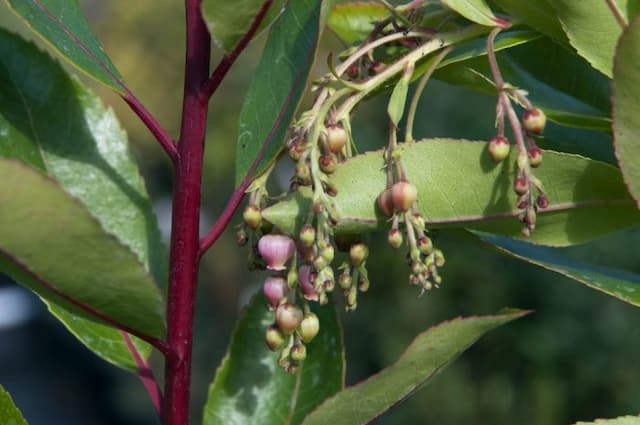Azalea Rhododendron 'Frank Galsworthy'

ABOUT
The Rhododendron 'Frank Galsworthy' features a striking display of blooms that can captivate anyone's attention during its flowering period. The plant is adorned with showy flowers that are typically bell-shaped and arranged in large, rounded clusters known as trusses. Each flower within these clusters has a vivid color, often in shades of pink, red, or purple, with subtle variations that can include intricate speckling or a subtle blending of hues near the throat. The blooms make a dramatic contrast against the foliage. The leaves of Rhododendron 'Frank Galsworthy' are equally impressive, characterized by a lush, deep green color. They are typically large, glossy, and leathery to the touch, with a thickness and durability that reflects the plant's resilience. These leaves are elongated, oval to oblong in shape, with smooth edges that sometimes curl slightly. The foliage remains evergreen, providing year-round interest even when the plant is not in bloom. Rhododendron 'Frank Galsworthy' overall presents a dense and bushy appearance, with a well-branched structure that lends itself to a rounded form. The texture and shape of the plant make it an ideal candidate for use as a specimen or as part of a mixed shrub border, offering both visual impact and structural form to the garden. Its captivating flowers and robust foliage ensure that Rhododendron 'Frank Galsworthy' is a prominent feature in any landscape where it is planted.
About this plant
 Names
NamesFamily
Ericaceae.
Synonyms
Rhododendron, Azalea.
Common names
Rhododendron 'Frank Galsworthy'
 Toxicity
ToxicityTo humans
The azalea is known to be toxic. All parts of the plant contain substances known as grayanotoxins, which can be poisonous to humans if ingested. The toxins can affect the body's sodium channels and disrupt normal cellular function. Symptoms of azalea poisoning may include nausea, vomiting, weakness, dizziness, difficulty breathing, and a drop in blood pressure. In severe cases, ingestion can lead to coma or even death.
To pets
Azaleas are toxic to pets, including dogs and cats. They contain grayanotoxins, which can interfere with normal cell function and lead to symptoms such as gastrointestinal upset, drooling, loss of appetite, weakness, leg paralysis, and in severe cases, even coma or death. It is important to prevent pets from ingesting any part of the azalea plant to avoid poisoning.
 Characteristics
CharacteristicsLife cycle
Perennials
Foliage type
Evergreen
Color of leaves
Green
Flower color
Pink
Height
6 feet (1.83 meters)
Spread
6 feet (1.83 meters)
Plant type
Shrub
Hardiness zones
7
Native area
Asia
Benefits
 General Benefits
General Benefits- Ornamental Appeal: Rhododendron 'Frank Galsworthy' offers vibrant flowers that enhance the aesthetic value of gardens and landscapes.
- Habitat for Wildlife: The plant provides shelter and nectar for pollinators such as bees and butterflies, supporting biodiversity.
- Seasonal Interest: With its distinctive blooms emerging in the spring, the Rhododendron adds seasonal interest to any planting area.
- Erosion Control: Its root system can help stabilize slopes and prevent soil erosion.
- Privacy Screen: When planted in groups, it can act as a natural privacy screen or windbreak.
- Shade Tolerance: The plant is capable of thriving in shaded areas where other sun-loving plants may struggle.
- Low Maintenance: Once established, Rhododendron 'Frank Galsworthy' requires minimal care beyond occasional pruning and watering.
- Versatility: It can be used in a variety of landscape designs, including formal and informal settings, woodland gardens and as a specimen plant.
 Medical Properties
Medical PropertiesThis plant is not used for medical purposes.
 Air-purifying Qualities
Air-purifying QualitiesThis plant is not specifically known for air purifying qualities.
 Other Uses
Other Uses- Rhododendron leaves can be used to create a natural dye for fabrics, resulting in a range of colors from tan to golden yellow depending on the mordant used.
- The wood of a Rhododendron is hard and dense, making it suitable for small woodworking projects such as handles for tools or carved ornaments.
- Rhododendrons can serve as a natural insect repellent; crushed leaves release certain compounds that insects find disagreeable.
- Dried Rhododendron flowers can be incorporated into potpourri blends for a unique visual appeal due to their bright coloration and shape.
- When cultivated for ornamental purposes, the Rhododendron can act as a living screen or hedge, providing privacy and reducing noise pollution.
- The beautiful blossoms of Rhododendron can be used in the culinary world as an edible decoration for desserts or in fancy cocktails.
- Rhododendron 'Frank Galsworthy' can be featured in photography projects or botanical illustrations due to their striking appearance.
- Rhododendron sap has been used historically as a natural adhesive or glue for small-scale repairs or crafts.
- While not commonly practiced, the petals of Rhododendrons can be used as confetti at weddings or celebrations, as they are biodegradable and colorful.
- The plant can be used as a learning tool in horticultural education, teaching about plant care, breeding, and hybridization techniques.
Interesting Facts
 Feng Shui
Feng ShuiThe Rhododendron is not used in Feng Shui practice.
 Zodiac Sign Compitability
Zodiac Sign CompitabilityThe Rhododendron is not used in astrology practice.
 Plant Symbolism
Plant Symbolism- Warning: Rhododendrons are often associated with caution or danger, as many species contain toxic substances that can be harmful if ingested.
- Elegance and Wealth: Due to their lush blooms and stately appearance, rhododendrons can symbolize elegance and prosperity.
- Homecoming and Nostalgia: In some cultures, rhododendron flowers are given to welcome someone home or to invoke fond memories, suggesting a sense of belonging.
- Survival: Rhododendrons are hardy plants capable of surviving in challenging environments, representing tenacity and the ability to overcome adversity.
 Water
WaterAzaleas, the common name for Rhododendron 'Frank Galsworthy', require consistent moisture but should not be overwatered. Water them deeply every week during the growing season, with about 1 inch of water, which is roughly 0.6 gallons for an average-sized plant. In hot or dry weather, increase watering to twice per week, ensuring the soil remains moist but not soggy. During the winter, reduce the frequency but do not let the soil completely dry out.
 Light
LightAzaleas thrive in partial shade with some shelter from intense midday sun. They prefer a spot that receives dappled sunlight throughout the day or light shade, as too much direct sunlight can burn the leaves and lead to stress.
 Temperature
TemperatureAzaleas are comfortable in temperatures ranging from 50°F to 80°F, making them suitable for a variety of climates. They can withstand brief drops to around 20°F but prolonged exposure to temperatures below this can be damaging. Ideally, maintain a temperature around 60°F to 70°F for optimal growth.
 Pruning
PruningAzaleas should be pruned to remove dead or diseased branches, maintain shape, and encourage bushier growth. Pruning is best done just after blooming ends in late spring or early summer, as the plant sets next year's flower buds soon after this year's blooms fade. Prune sparingly, as excessive cutting can reduce flowering.
 Cleaning
CleaningAs needed
 Soil
SoilThe Azalea (Rhododendron 'Frank Galsworthy') requires acidic soil with a pH of 4.5 to 6.0. A well-draining soil mix composed of 50% peat moss, 30% pine bark, and 20% perlite would be ideal to provide the necessary airflow and moisture retention. Regularly test soil pH to maintain acidity.
 Repotting
RepottingAzaleas, including the variety 'Frank Galsworthy,' should generally be repotted every 2-3 years. Repotting should be done in the spring, and it is crucial only to go up one pot size at a time to prevent root rot from excess soil.
 Humidity & Misting
Humidity & MistingThe Azalea flourishes in high humidity environments, with an ideal range of 40-60% humidity. Ensure good air circulation to prevent issues such as mold or fungus, especially if the indoor air is humidified.
 Suitable locations
Suitable locationsIndoor
Ensure bright, indirect light, high humidity, and occasional misting.
Outdoor
Plant in partial shade, mulch, and shelter from strong winds.
Hardiness zone
5-8 USDA
 Life cycle
Life cycleRhododendron 'Frank Galsworthy', more commonly known as Azalea, begins its life cycle as a seed, which germinates in a moist and well-drained acidic soil environment, typically in the spring. After sprouting, the seedling grows into a young plant with characteristic leaves and gradually develops a woody stem. Throughout the growing season, the Azalea enters a vegetative stage characterized by substantial leaf and branch growth. The maturity stage is reached when the plant starts to produce flowers, often in vibrant colors and usually blooming in the spring. After pollination by insects, the flowers develop into seed capsules, and once mature, these capsules release seeds, completing the reproductive cycle. Lastly, the Azalea plant may enter a period of dormancy during colder months, conserving energy to begin the cycle anew come spring.
 Propogation
PropogationPropogation time
Early Spring
Rhododendron 'Frank Galsworthy', commonly known just as Rhododendron, is typically propagated through semi-hardwood cuttings. The best time to do this is in the late summer or early fall when the new growth has begun to firm up. To propagate by cuttings, a 4 to 6-inch length (approximately 10 to 15 centimeters) cutting should be taken from the current year's growth. The bottom leaves are removed and the cut end can be dipped in rooting hormone to increase the chances of success. This prepared cutting is then placed in a mix of peat and perlite, ensuring good drainage and moisture retention. The cutting should be kept in a well-lit area but out of direct sunlight and maintained at a consistent humidity level to encourage rooting, which could take several weeks.
